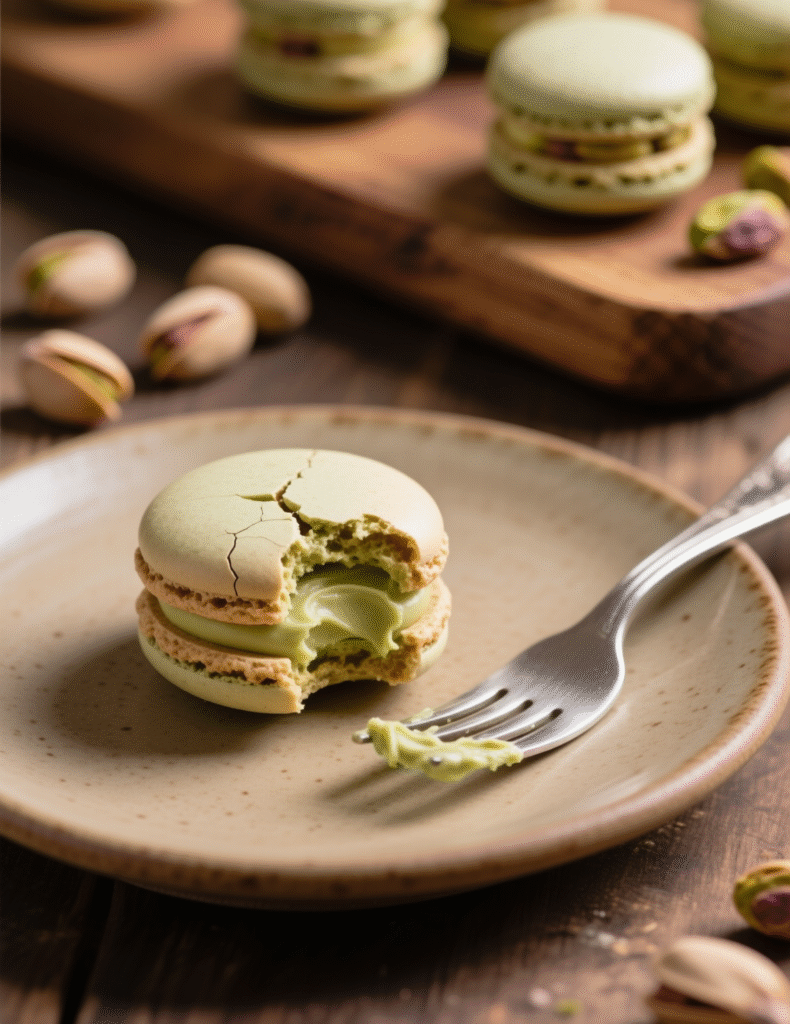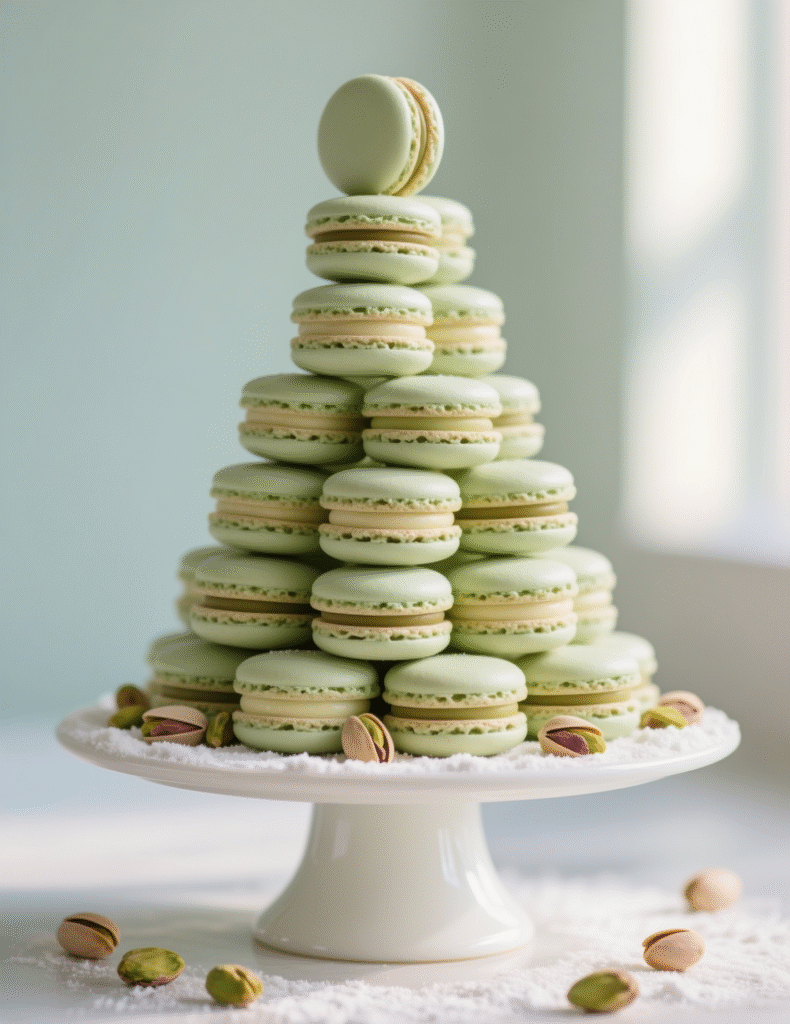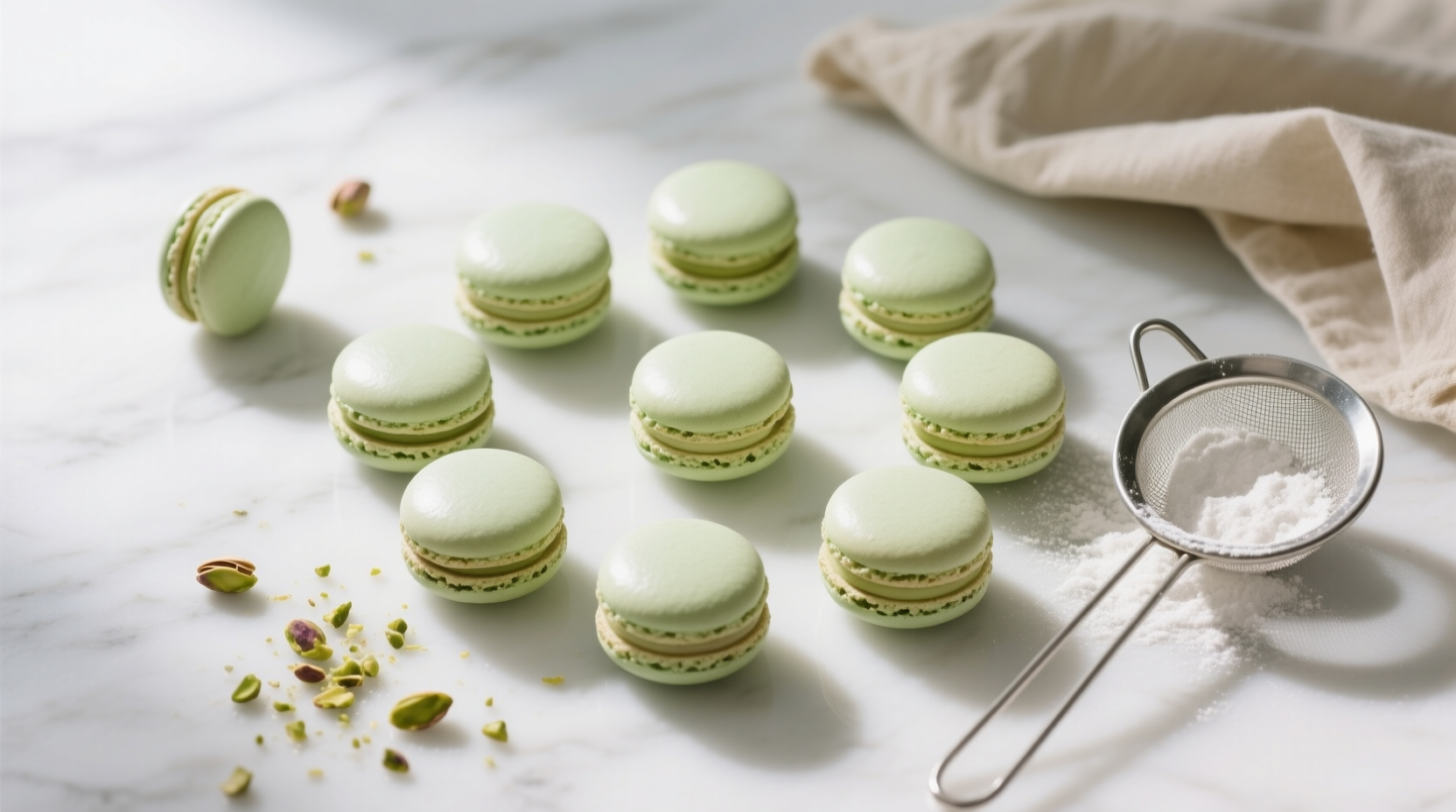There’s something about pistachio macarons that makes pastry chefs pause for a moment. The pale green shells, crisp but delicate, sandwiching a creamy pistachio filling—it’s as close to edible art as you’ll get. But here’s the truth: making these little gems is not easy. That’s exactly why they’ve become a benchmark in professional pastry kitchens, the kind of dessert that quietly tests your patience and your precision.
Why Pistachio Macarons Are Worth Mastering
Ask any French-trained chef about macarons and you’ll see a little glint in their eye. They’re simple in theory—egg whites, sugar, almond flour—but the execution is where most people slip. Pistachio macarons add one more layer of challenge because the nut flavor must come through without overpowering the shell’s delicate texture. Too much ground pistachio? Your batter becomes heavy. Too little? You lose that earthy, nutty character people expect.
And let’s not forget pistachios aren’t cheap. Global production hovers around 1.1 million metric tons a year, with Iran and the US leading the harvest. A misstep in a recipe that uses finely ground pistachio flour feels not just like failure, but also a waste of premium ingredients. That’s why pastry professionals take this flavor so seriously.
The Anatomy of a Perfect Macaron
Before diving into the recipe, let’s look at what we’re really chasing. A macaron shell should have a smooth, shiny top with no cracks. Its feet—the ruffled base that develops during baking—must be well-defined but not too spread out. When you bite, the shell gives a slight crisp before melting into a soft, chewy center.
The pistachio filling can be approached in a few ways. Classic French buttercream, pistachio ganache, or even pistachio paste whipped with mascarpone. Each has its own texture profile, and honestly, choosing comes down to the purpose. For high-end patisserie display? Buttercream holds better. For indulgent richness? Ganache wins. For a lighter, rustic style? Mascarpone all the way.
Ingredients That Actually Matter
One of the biggest misconceptions is that you can make macarons with whatever almond flour is on sale. No. You need superfine almond flour with no skins. Any coarseness, and your shells will look like sandpaper. For pistachio macarons, about 20–25% of that almond flour can be swapped with ground pistachios. Push past that ratio, and you risk density issues.
Egg whites are another ingredient people underestimate. Professional kitchens often age them for 24–48 hours, loosely covered, in the refrigerator. Aging reduces moisture and strengthens protein structure, which means better stability when whipping. Some chefs even prefer powdered egg whites (albumen) to boost consistency.
And don’t skimp on the pistachio paste. Real pistachio paste should be 100% nuts, no fillers. Many cheaper commercial versions mix in sugar or vegetable oil. The best ones come from Italy, particularly Bronte in Sicily, where the pistachios are considered some of the finest in the world.

Step-by-Step Pistachio Macaron Recipe
Ingredients for the Shells
- 110g almond flour (superfine)
- 30g pistachio flour (finely ground, unsalted pistachios)
- 150g confectioners’ sugar
- 100g egg whites (aged if possible)
- 90g granulated sugar
- A pinch of cream of tartar (optional)
- Green gel food coloring (sparingly used)
Ingredients for Pistachio Buttercream Filling
- 200g unsalted butter, softened
- 150g confectioners’ sugar
- 80g pistachio paste (pure, no additives)
- 1 tsp vanilla extract
- 1–2 tbsp heavy cream if needed
Method
- Prepare Dry Mix: Sift almond flour, pistachio flour, and confectioners’ sugar together. Do it twice. It feels excessive, but this is how you avoid lumpy shells.
- Make the Meringue: Whip egg whites on medium until foamy. Add cream of tartar if using. Slowly rain in granulated sugar, continue beating until stiff, glossy peaks form. Not dry peaks—just at that moment before they stiffen too much.
- Macaronage: Fold the dry mixture into the meringue gently. Use a spatula to press batter against the bowl, deflating slightly. The batter should flow like thick lava. Test with the figure-eight method—it should fold without breaking.
- Pipe: Transfer batter into a piping bag with a round tip. Pipe small rounds on a silicone mat or parchment, spacing well. Tap the tray hard against the counter to release air bubbles. Pop stubborn ones with a toothpick.
- Rest: Leave shells uncovered for 30–60 minutes. You’re waiting for a skin to form on top. When you can lightly touch a shell without sticking, they’re ready to bake.
- Bake: Preheat oven to 300°F (150°C). Bake for 15–18 minutes, turning the tray halfway through. Shells should not brown. Allow to cool before removing.
- Filling: Beat butter until fluffy. Add confectioners’ sugar, pistachio paste, and vanilla. Adjust with cream for spreadability.
- Assemble: Match shells by size. Pipe filling onto one shell, sandwich with another. Refrigerate macarons at least 24 hours to mature—this resting time melds flavors and improves texture.
Troubleshooting Pistachio Macarons
Cracked tops? Likely overbeaten meringue or insufficient resting time. Hollow shells? Often caused by underbaking or too much air in the batter. No feet? Oven too cool or batter undermixed. It’s a balancing act that can make even seasoned chefs grit their teeth.
One clever tip from Pierre Hermé, the Parisian “Picasso of Pastry,” is to test a single macaron before baking the entire tray. If that one bakes correctly, you’re good. If not, you’ve only lost a small portion and can tweak the oven settings.
Why Pistachio is a Chef’s Favorite Flavor
Pistachio offers a complex flavor profile—nutty, slightly sweet, faintly earthy. Unlike hazelnut or almond, pistachio feels less sugary and more sophisticated. That’s why it’s a darling in French patisserie. According to global pastry market studies, pistachio remains among the top three nut flavors in luxury desserts, alongside hazelnut and almond.
Chefs also love its color. A natural pale green adds visual charm, though most professionals still enhance it with a hint of gel food coloring. Natural pistachio alone often bakes into beige, which can disappoint customers expecting a pop of green.
Emerging Trends in Macaron Crafting
In 2025, professional kitchens are exploring hybrid fillings for pistachio macarons. Think pistachio–raspberry ganache or pistachio–yuzu cream. The acidity balances the richness of the nut. Vegan pistachio macarons are also gaining traction, replacing egg whites with aquafaba (chickpea brine). While not as stable, the results are impressive enough for plant-based patisserie menus.
Another rising trend is using pistachio praline paste instead of pure pistachio paste. This adds caramelized depth, almost like pistachio toffee, which layers beautifully with the crisp shells.
Storage and Shelf Life
Macarons mature best after 24 hours in the fridge. They keep well for 3–4 days when stored in an airtight container at 4°C. Beyond that, shells soften excessively. Freezing is possible—freeze filled macarons on a tray, then store in airtight containers. Thaw overnight in the refrigerator. Professional kitchens often make them in bulk this way, especially for events.
Common Misconceptions
People often confuse macaron and macaroon. They’re not even cousins. A macaron is French, refined, almond-based. A macaroon is coconut-based, chunky, chewy. Another misconception? That macarons are impossible for home bakers. Truth is, with practice and a decent oven thermometer, they’re very achievable.

Final Thoughts
Pistachio macarons are more than a recipe. They’re a skill test, a statement of control over precision and patience. Professional chefs know that behind every perfect green shell lies hours of practice, failed batches, and small victories.
If you’re serious about mastering them, don’t rush. Start with the best ingredients, respect the process, and accept that mistakes are part of the learning curve. When you finally nail them, that first perfect bite—crisp, chewy, nutty, creamy—will remind you exactly why you chased pistachio macarons in the first place.
FAQs
What makes pistachio macarons different from regular macarons?
They use finely ground pistachios and pistachio paste for a unique nutty flavor and pale green color.
Can I replace almond flour entirely with pistachio flour?
No, only 20–25% can be swapped or the shells will become too dense.
Why do my macarons crack on top?
Cracks usually come from undermixing, overwhipped meringue, or skipping the resting step.
How long should I age egg whites for macarons?
Between 24–48 hours in the fridge, loosely covered, works best for stability.
Do I need pistachio paste or can I just grind nuts?
Pure pistachio paste gives a stronger, smoother flavor than just ground pistachios.
Why don’t my macarons have feet?
This often happens if the oven temperature is too low or the batter is undermixed.
How long should macarons rest before baking?
Typically 30–60 minutes, until a skin forms and shells don’t stick to your finger.
How long do pistachio macarons last?
They keep well in the fridge for 3–4 days or can be frozen for longer storage.
Do I have to use food coloring for pistachio macarons?
No, but without it they may bake beige instead of the expected pale green.
Can I make vegan pistachio macarons?
Yes, by using aquafaba instead of egg whites, though stability is a bit trickier.

Mariana is a passionate home cook who creates delicious, easy-to-follow recipes for busy people. From energizing breakfasts to satisfying dinners and indulgent desserts, her dishes are designed to fuel both your body and hustle.
When she’s not in the kitchen, she’s exploring new flavors and dreaming up her next recipe to share with the Foodie Hustle community.

